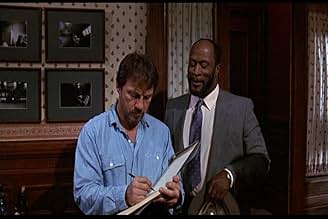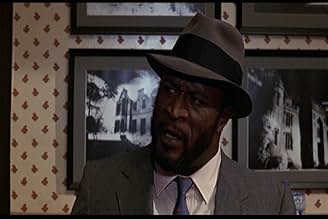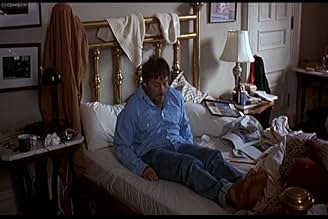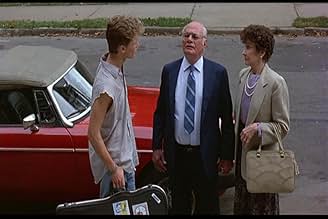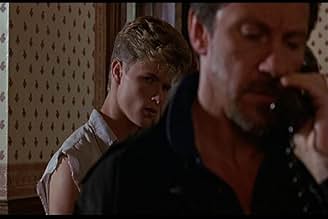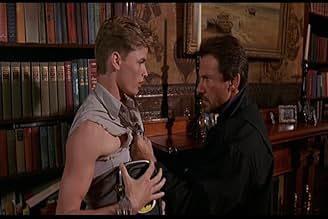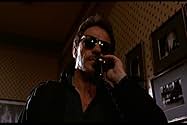CALIFICACIÓN DE IMDb
6.1/10
8.7 k
TU CALIFICACIÓN
Dos cuentos de terror basados en cuentos de Edgar Allan Poe. Una esposa codiciosa mata a su marido, pero no del todo. Un reportero adopta un extraño gato negro.Dos cuentos de terror basados en cuentos de Edgar Allan Poe. Una esposa codiciosa mata a su marido, pero no del todo. Un reportero adopta un extraño gato negro.Dos cuentos de terror basados en cuentos de Edgar Allan Poe. Una esposa codiciosa mata a su marido, pero no del todo. Un reportero adopta un extraño gato negro.
- Dirección
- Guionistas
- Elenco
- Premios
- 3 nominaciones en total
Holter Graham
- Christian (segment "The Black Cat")
- (as Holter Ford Graham)
Opiniones destacadas
It's always tricky to evaluate a filmmaker when at work on a film that is in an in-between realm of short and feature. Actually, by technical ruling (or what would be considered by most festivals), it is feature-length with each segment. But I found Two Evil Eyes an underrated effort, after reading many mixed reviews (many leaning to the lesser side for especially Romero's film, and some faint praise for Argento's). The Facts in the Case of Mr. Valdemar and The Black Cat are not the tippy-toppest best for either filmmaker, and for Romero it's a strange kind of quasi-conventional experiment while Argento stays in somewhat familiar territory. Each has its own strengths, own weaknesses, and it's a fine little treat.
'Valdemar': This starts with the veneer of what comes in the range of something like a cross between daytime Soap and a 40s melodrama. A woman (Adrienne Barbeau) married Mr. Valdemar late in life, and as he's about to die (and soon does) she stands to collect a load of money with her cuckold- a smooth operating doctor who has a knack for hypnosis.
What unfolds after his death, and their cover-up in order to secure more funds, is something still like a 'living-dead' movie for the director, but more psychological in head-games and, to be sure, a faithfulness to the Poe source. It is a peculiar feat to adjust to in seeing Romero, at least in the first half hour, directing more like an old pro of the studio era than with his trademark panache in editing and shocks.
This time he brings on the dread in a gradual fashion, built on guilt and paranoia, and then as Valdemar is in that freezer, a Gothic form of psychosis: two people stuck with a body, and a voice, they can't get rid of and become absorbed with. I liked it a lot- maybe more than I should have from what I read (the 'Soap' argument against it I read before, though Romero does try to give his actors more to work with than any hack would)- as it preys on the fear of death as not a final measure, with one last wicked kick in the nuts with that bed scene. Top shelf Romero? Not quite, but it's still oddly gripping, like a polished piece of clichés giving way to a wild head game of "old-school" horror.
8/10 'Black Cat': Argento's dip in the Poe pool goes to the lengths that he as a director always goes to: elaborate-to-the-Italian-horror degree style in camera and deranged horror, and even bits of dark horror that almost make Poe seem tame. I can't say how much this is tied into Poe more than I can Valdemar, but try as I might I couldn't see this as being totally peak Argento either, despite (or almost in spite of) everything he has going for it. Like Valdemar, it's about someone not coping with life after death; a photographer (Keitel) into the macabre, with a (color me shocked Argento) violinist girlfriend, has a black cat, whom the photographer strangles while taking some provocative photos. She knows he's behind it, but he can't stop himself- he needs another cat- just like the old cat- which will meet some grisly consequences.
Keitel's always game for something like this part, which plays like his Bad Lieutenant gone Grand Guignol, which makes for one of the best pleasures of the project. He doesn't have a whole lot of range in the role, but it's a fun one for him, chewing on the meat that Argento throws out for him scene after scene. Argento, meanwhile, even for *him* overdoes it with the horror music in certain scenes, and dares to go to too much excess with the symbolism of the white spots on the cat. But it's totally a wonder to see that dream sequence, where Keitel is in the midst of a medieval Pagan sacrifice, with a sharp cut-away in the most violent bit.
And I loved the pleasure that Argento takes in enlivening Poe's macabre with his own, with the violence extending from mania into the visual. I had my complaints at times, but it's hard to not throw up one's hands with Argento and say "why carp!" when he's unabashed in his passions of mostly constant camera movement (tracking, cranes, close-ups, pans, you-name-it) and illogical steps in plot (i.e. why Keitel's character would even put out a book with cat deaths knowing his girlfriend might see them, let alone so soon).
8/10 Bottom line, fans of the directors should check out the films, and decide for themselves how they do. It's two tall tales of curses and death, derangement and the surreal, and it's a concoction worth at least one viewing.
'Valdemar': This starts with the veneer of what comes in the range of something like a cross between daytime Soap and a 40s melodrama. A woman (Adrienne Barbeau) married Mr. Valdemar late in life, and as he's about to die (and soon does) she stands to collect a load of money with her cuckold- a smooth operating doctor who has a knack for hypnosis.
What unfolds after his death, and their cover-up in order to secure more funds, is something still like a 'living-dead' movie for the director, but more psychological in head-games and, to be sure, a faithfulness to the Poe source. It is a peculiar feat to adjust to in seeing Romero, at least in the first half hour, directing more like an old pro of the studio era than with his trademark panache in editing and shocks.
This time he brings on the dread in a gradual fashion, built on guilt and paranoia, and then as Valdemar is in that freezer, a Gothic form of psychosis: two people stuck with a body, and a voice, they can't get rid of and become absorbed with. I liked it a lot- maybe more than I should have from what I read (the 'Soap' argument against it I read before, though Romero does try to give his actors more to work with than any hack would)- as it preys on the fear of death as not a final measure, with one last wicked kick in the nuts with that bed scene. Top shelf Romero? Not quite, but it's still oddly gripping, like a polished piece of clichés giving way to a wild head game of "old-school" horror.
8/10 'Black Cat': Argento's dip in the Poe pool goes to the lengths that he as a director always goes to: elaborate-to-the-Italian-horror degree style in camera and deranged horror, and even bits of dark horror that almost make Poe seem tame. I can't say how much this is tied into Poe more than I can Valdemar, but try as I might I couldn't see this as being totally peak Argento either, despite (or almost in spite of) everything he has going for it. Like Valdemar, it's about someone not coping with life after death; a photographer (Keitel) into the macabre, with a (color me shocked Argento) violinist girlfriend, has a black cat, whom the photographer strangles while taking some provocative photos. She knows he's behind it, but he can't stop himself- he needs another cat- just like the old cat- which will meet some grisly consequences.
Keitel's always game for something like this part, which plays like his Bad Lieutenant gone Grand Guignol, which makes for one of the best pleasures of the project. He doesn't have a whole lot of range in the role, but it's a fun one for him, chewing on the meat that Argento throws out for him scene after scene. Argento, meanwhile, even for *him* overdoes it with the horror music in certain scenes, and dares to go to too much excess with the symbolism of the white spots on the cat. But it's totally a wonder to see that dream sequence, where Keitel is in the midst of a medieval Pagan sacrifice, with a sharp cut-away in the most violent bit.
And I loved the pleasure that Argento takes in enlivening Poe's macabre with his own, with the violence extending from mania into the visual. I had my complaints at times, but it's hard to not throw up one's hands with Argento and say "why carp!" when he's unabashed in his passions of mostly constant camera movement (tracking, cranes, close-ups, pans, you-name-it) and illogical steps in plot (i.e. why Keitel's character would even put out a book with cat deaths knowing his girlfriend might see them, let alone so soon).
8/10 Bottom line, fans of the directors should check out the films, and decide for themselves how they do. It's two tall tales of curses and death, derangement and the surreal, and it's a concoction worth at least one viewing.
Two mad tales by Edgar Allen Poe as envisioned by two of the most respected horror directors in the world. In The Facts in the Case of Mr. Aldemar we are shown the evils of greed when the wife of a dying man is manipulated through hypnosis to steal his fortune before his death. But when the doorway between our world and the next is inexplicably held open we are introduced to the others. In The Black Cat we are introduced to Usher a crime scene photographer with a dark side and the eye for the macabre. When a proposed photography book falls through he uses his girlfriends cat to add more evil to his already twisted book. But this cat has more than nine lives and an evilness all its' own.A solid outing by two of my all time favorite directors. Barbeau and Keitel steal their respective episodes but look for cameos by Christine Romero and the FX guru Tom Savini. The production design is solid and the make-up effects (by Savini's crew) are awesome. Both tales are briskly paced and fans of the directors' should be pleased. 7/10
Instead of your usual trilogy or anthology, TWO EVIL EYES is two hour-long Edgar Allan Poe adaptations written for the screen and directed by two top horror directors. "The Facts in the Case of Mr. Valdemar" (by George A. Romero) concerns a money-hungry wife (Adrienne Barbeau) and a greedy doctor (Ramy Zada) who team up to kill off the elderly husband Ernest (Bingo O'Malley) for his money. They unwisely use hypnotism to lure the victim to catatonia, which also allows Ernest to return from the dead and seek revenge. The storyline is too cliché in this outing and it's pretty dull despite an excellent lead performance from Barbeau and good (though sparsely used) Tom Savini make up FX. "The Black Cat" (by Dario Argento) is the reason to watch the movie. Harvey Keitel is typically good as Roderick Usher, an alcoholic crime photographer who makes a living publishing mondo photographs. His book ("Metropolitan Horrors") stirs up lots of controversy. The horror angle is added by a sinister black cat that constantly pops up in Usher's life and starts to drive him mad. Mixing elements from several Poe stories, Argento's flair for visual style and color schemes, loads of clever Poe reference (including nods to his "Pit and the Pendulum" and "Premature Burial") and lots of surprises, "The Black Cat" manages to be both entertaining and disturbing. Tom Savini also did FX for the segment (and appears). Pino Dinaggio did music for both.
Two Evil Eyes is a collaboration by two horror masters; George A. Romero (Night of the Living Dead), and Dario Argento (Suspiria). Special effects are also provided by the top name in horror movies of the period, Tom Savini. To top it off, both stories are based on works by Edgar Allan Poe, arguably one of the largest influences on works of horror, well... ever. And the efforts of these great names quite lives up to expectations. In fact, it may succeed them if you are aware of the decline in the quality of output by both of these directors around this time period. Romero's next film after Two Evil Eyes was the appalling King adaptation The Dark Half, and Argento's the lukewarm Trauma. So if one is knowledgeable of this it would be nothing but natural to approach this film tentatively. Fortunately, your fears will be calmed. The first half is titled The Facts in the Case of M. Valdemar, and is based on the Poe short story of the same name. Romero's adaptation is a fun and concise update. The storyline is engaging, easy to follow, well acted, well shot. I wouldn't say that it's going to blow your mind but it's certainly enjoyable. Argento's effort, as would be expected, was somewhat more complicated. In terms of quality, plot, and appearance. The Black Cat is, mainly, based on the well known Poe story of the same name. It also incorporates nods to other works by the author and the main character's last name is Usher. The story is somewhat muddled and confusing, but that really comes with the territory when Argento is concerned. There are also a few questionable set choices but overall I really found the second half very enjoyable as well. Overall I really think that Two Evil Eyes is a pretty damn enjoyable selection and probably more even than I've made it sound. It's better than its place in the filmographies of the respective directors would suggest as well.
This film is an average entry from both directors. If you're a huge horror fan, it's interesting from the perspective that you can compare and contrast both Argento and Romero's styles as they both tackle material from Poe. Just from what I briefly read it seems like this film had some production troubles, so I can't really fault the movie for what it was. It was an experiment that worked in some places, and didn't work in others; it's pretty middling overall.
¿Sabías que…?
- TriviaDario Argento originally wanted the film to be a collaboration between four directors: him, George A. Romero, John Carpenter, and Wes Craven. Carpenter and Craven pulled out, so Argento and Romero decided to tackle the project as a two-part story, each directing his own segment separately.
- ErroresIn second story when police comes to search the house, phone is shown unplugged and not working, but it rings just a few minutes later, working fine.
- Citas
Roderick Usher (segment "The Black Cat"): Hey, this is my fucking kitchen , and I'll fucking stay, and I'll fucking drink if I fucking want!
[phone rings]
Roderick Usher (segment "The Black Cat"): I DIDN'T FUCKING DO ANYTHING!
- Créditos curiososBefore the narrative of the film starts, the Poe house in Baltimore is shown, with a plaque reading: Edgar Allan Poe 1809 1849 Dreaming dreams no mortal ever dared to dream before.
- ConexionesFeatured in Dario Argento: Master of Horror (1991)
Selecciones populares
Inicia sesión para calificar y agrega a la lista de videos para obtener recomendaciones personalizadas
- How long is Two Evil Eyes?Con tecnología de Alexa
Detalles
- Fecha de lanzamiento
- Países de origen
- Idioma
- También se conoce como
- Two Evil Eyes
- Locaciones de filmación
- 1250 Fox Chapel Road, Fox Chapel, Pittsburgh, Pensilvania, Estados Unidos(Valdemar mansion - segment "The Facts in the Case of Mr. Valdemar")
- Productoras
- Ver más créditos de la compañía en IMDbPro
Taquilla
- Presupuesto
- USD 9,000,000 (estimado)
- Total en EE. UU. y Canadá
- USD 349,618
- Fin de semana de estreno en EE. UU. y Canadá
- USD 260,410
- 27 oct 1991
- Total a nivel mundial
- USD 349,618
- Tiempo de ejecución2 horas
- Color
- Mezcla de sonido
- Relación de aspecto
- 1.85 : 1
Contribuir a esta página
Sugiere una edición o agrega el contenido que falta

Principales brechas de datos
By what name was Dos ojos diabólicos (1990) officially released in India in English?
Responda

